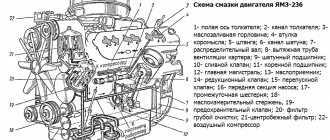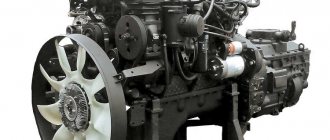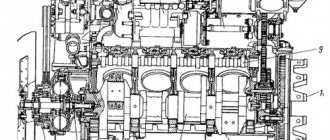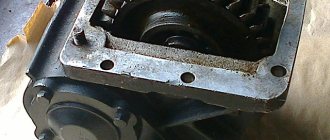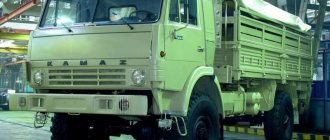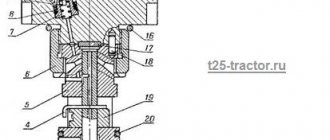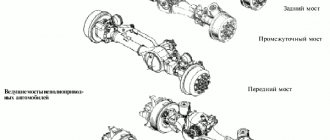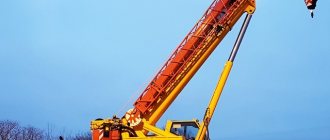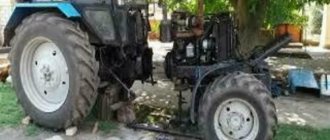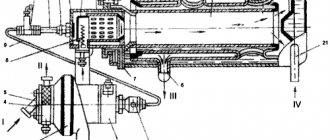The power supply system of a modern diesel internal combustion engine is a whole complex of devices. The main task is not just supplying fuel to the injection nozzles, but also supplying fuel under high pressure. Pressure is necessary for high-precision dosed injection into the combustion chamber of the cylinder. The diesel power system performs the following essential functions:
- dosing a strictly defined amount of fuel, taking into account the load on the engine in a particular mode of operation;
- effective fuel injection in a given period of time with a certain intensity;
- atomization and maximum uniform distribution of fuel throughout the volume of the combustion chamber in the cylinders of a diesel internal combustion engine;
- preliminary filtration of fuel before supplying fuel to power system pumps and injection nozzles;
We also recommend reading the article about the design of the high-pressure fuel pump. From this article you will learn about the operating principles of the injection pump, its role in the fuel supply system of a diesel engine and the operating features of the device.
Diesel fuel
Diesel fuel is one of the products of oil refining. It contains various hydrocarbons (paraffins, naphthenes, aromatics, etc.). The number of carbon atoms included in diesel fuel molecules reaches thirty. The main quality of diesel fuel is its ease of ignition when in contact with hot air. The flammability of fuel is characterized by the cetane number. The higher this number, the less resistant the fuel molecules are to oxidation and the more easily it ignites. Diesel fuel has a cetane number of 40 - 50 (most often 45).
An important characteristic of fuel is also its viscosity at different temperatures. To ensure normal engine operation, fuel should not solidify at low temperatures (up to -60 ° C). In addition, it is necessary that the fuel is non-toxic, has anti-corrosion and lubricating properties, and does not create vapor locks in fuel lines at temperatures up to 50 ° C.
Automotive diesel engines use fuel grades A (Arctic), 3 (winter) and L (summer). The most widely used fuels are grades Z (at negative air temperatures) and L (at temperatures above 0 °C).
Requirements for units and components of the power supply system
The following basic requirements apply to all units and components of the power system:
- tightness
- small weight and dimensions
- reliability
- corrosion resistance
- low hydraulic resistance
- simplicity
- low maintenance cost
Fuel lines and fuel supply system units must be located in the engine compartment of the vehicle in such a way that if they malfunction, dripping fuel does not fall on parts that have a temperature that could cause it to ignite.
Common Rail
After a significant tightening of environmental standards for diesel power plants, the power supply system for diesel engines has undergone changes.
The fuel supply scheme, when a mixture of air and fuel enters the working chamber at atmospheric pressure, became known as Common Rail. As a result, due to this principle, it is possible to reduce consumption and increase the power of the installation. In addition, the circuit has become widely used due to reduced noise and increased motor torque. Today, every second car is equipped with this system.
However, like every mechanism, there are also disadvantages. For example, this system requires high-quality fuel; slight contamination can lead to a complete stop of the unit, since the operation of the injectors will be blocked.
General structure of the power system
The diagram of the fuel supply system for a powerful diesel engine is shown in the figure. In general, the fuel supply system includes components located outside the engine (on the frame or in the body of the machine) and on the engine. The first include fuel tanks: fuel collection tank 7, pre-start fuel priming pump 10, fuel distribution valve 77, low pressure fuel lines and some other components. The latter primarily include the main fuel priming pump 8, the high-pressure fuel pump (HPF) 5, the injectors 4 and the high-pressure fuel lines.
When the engine is running, fuel is taken from the fuel tanks by the main fuel pump and supplied to the injection pump under a pressure of 0.05...0.1 MPa. On the way from the tanks to the pump, the fuel passes through the fuel distribution valve, the pre-start fuel priming pump and the coarse filter 9. If the vehicle has only one fuel tank or several tanks communicating with each other, then there is no fuel distribution valve. Before entering the injection pump from the pump, the fuel is cleaned of the smallest impurities in a fine filter 3. The injection sections of the injection pump, driven from the engine crankshaft, at certain moments, according to the operating cycle and operating order of the engine, supply fuel under high pressure (up to 50 MPa or more) in the required quantity to the injectors. Through injectors screwed into the cylinder head, fuel is injected into the combustion chambers at the moments when the compression stroke in the cylinders completes.
Rice. Diagram of the fuel supply system for a powerful diesel engine: 1 - fuel tanks; 2 - valve for air release; 3 — fine filter; 4 — nozzles; 5 injection pump; 6 - engine; 7 — tank for collecting fuel; 8 — main fuel pump; 9 — coarse filter; 10 — pre-start fuel priming pump; 11 — fuel distribution valve; fuel pipelines are indicated by a solid line; pipelines for removing air from the system are indicated by dotted lines
Before starting the engine, the system is filled with fuel and supplied to the fuel injection pump using a pre-start fuel priming pump. After starting, this pump does not function.
If air enters the injection pump and the high-pressure pipelines connecting it to the injectors, the fuel supply to the cylinders is disrupted. Consequently, the normal operation of the engine is disrupted. In order to prevent air from entering the fuel injection pump along the fuel path, an air separator is placed next to it, located at the highest point of the system. Typically, the air separator is placed in the cover of the fine filter. Before starting the engine, if necessary, the air accumulated in the air separator is diverted into the air cavities of the fuel tanks 1 through the tap (valve) 2 to release air. To do this, with the engine not running, open the tap (valve) and use the pre-start pump to bleed the system. In this case, the fuel displaces air from the air separator into the air cavity of the fuel tank through the fuel distribution valve (as shown in the figure) or directly.
Diesel Engine Low Pressure Fuel Pump
The TNND pump is also part of the diesel power system. It is installed in close proximity to the injection pump pump, connected to it using pipes through which fuel circulates. Diesel fuel is pumped from the tank using a special pump. The fuel injection pump is often called the booster pump of a diesel engine; it consists of two working gears that are in constant mesh. When they rotate, a flow of diesel fuel is created, directed towards the injection pump.
If it is noticed that the performance of the fuel pumping mechanism of the low pressure fuel pump has decreased, it is recommended to dismantle it for further cleaning and flushing. More serious repairs consist of replacing failed elements with new parts included in special repair kits.
Fuel tank
The fuel leaked into the nozzles between the needle and the nozzle is discharged through drain pipelines into a special tank 7 or into some main fuel tank.
Fuel tanks are used to store fuel. They can have different configurations and capacities depending on the design of a particular vehicle. The total capacity of the fuel tanks is determined by the vehicle's range (usually at least 500 km). Most often, tanks are made of sheet steel or high-strength plastic that is resistant to chemically active fuel. To prevent corrosion, the internal surfaces of steel tanks are coated with bakelite varnish, galvanized or tinned. In order to increase the rigidity of the tanks, sometimes grooves are stamped on their walls, and non-solid partitions are installed inside, which also reduce the free surface area of the fuel and weaken its vibrations during vehicle movement.
Filler necks of fuel tanks are usually equipped with strainers. Settling tanks are placed at the bottom of the tanks. If the tank has a significant capacity, then the fuel is drained through a hole with a plug and a ball valve located above the sump. In this case, a special wrench with a hose is used. The air space of the tanks is connected to the atmosphere through drainage tubes or other special devices, which should exclude the possibility of fire entering the internal cavity of the tank and fuel leaking out during sudden shocks of the vehicle, and also (if possible) ensure purification of the air entering the tanks. Measuring rods were previously used to measure the amount of fuel in tanks. Currently, for this purpose, electrical float-type sensors are most often used, sending an electrical signal proportional to the fuel level to the corresponding indicator on the vehicle dashboard.
Tuning
Chip tuning of diesel engines can be performed both by reprogramming the control unit and by changing the turbine pressure.
It should be said that chip tuning of a diesel engine is simple and affordable. At the same time, it allows you to significantly increase the power of the motor without reducing its service life.
Note that for high-quality operation of such a chipped power unit, it is necessary to remove the catalysts or install their decoys. It should be remembered that chip tuning of a diesel engine should be performed exclusively by an experienced specialist who knows what compression should be in the engine.
Currently, there are various programs to increase the power of the power unit by reprogramming its control unit. In this case, there is the possibility of both easy tuning and a dramatic increase in power.
Fuel lift pump
The main fuel priming pump ensures uninterrupted supply of fuel from the tanks to the injection pump when the engine is running. It is usually driven by the engine's crankshaft or camshaft. An autonomous electric motor powered by a vehicle generator can also be used. The use of an electric drive ensures uniform fuel supply regardless of the crankshaft speed and the possibility of emergency shutdown of the entire system. There are various designs of fuel priming pumps. They can be:
- gear
- plunger (piston)
- rotary (plate type)
As a rule, plunger and rotary pumps are used.
Plunger fuel priming pump
The plunger fuel priming pump consists of a housing 5, a plunger 7 with a spring 6, a pusher 10 with a roller 77, a spring 9 and a rod 8, as well as valves - inlet 4 and discharge 1 with springs. The pusher and plunger can move up and down. The upward movement occurs when the eccentric 72, manufactured as one piece with the injection pump cam shaft, is turned; downward movement is provided by springs 6 and 9.
When the eccentric protrusion runs off the pusher roller, the plunger moves downward under the action of spring b, displacing the fuel located under it into the pump discharge line. At this time, the discharge valve is closed, and the intake valve is open under the influence of vacuum above the plunger, and fuel flows from the intake line into the cavity above the plunger. When the pusher and plunger move upward, the inlet valve closes under the influence of fuel pressure, and the discharge valve, on the contrary, opens, and fuel from the cavity above the plunger enters the lower chamber under the plunger. Thus, fuel injection occurs only when the plunger moves downwards.
If the fuel supply to the engine cylinders is reduced, the pressure in the exhaust pipe of the pump, and therefore in the cavity under the plunger, increases. In this case, the plunger cannot move down even under the action of spring 6, and the pusher with the rod moves idle. As fuel is consumed, the pressure in the discharge cavity decreases, and the plunger, under the action of spring 6, again begins to move downward, providing fuel supply.
Rice. Diagram of a plunger fuel priming pump: 1 - discharge valve; 2 — manual fuel pump housing; 3 — piston of the manual fuel pump; 4 — inlet valve; 5 — fuel pump housing; 6, 9 — springs; 7 - plunger; 8 — rod; 10 - pusher; 11 — roller; 12 - camshaft eccentric
Rice. Diagram of a rotary fuel priming pump: 1 — pressure reducing valve spring; 2 - pressure reducing valve; 3 - bypass valve; 4 — bypass valve spring; 5 - floating finger; 6 - plate; 7 - rotor; 8 — guide glass; A—B—pump chambers
The plunger fuel priming pump is usually combined with pump 2 for manual fuel priming. This pump is installed at the inlet of the main fuel pump and is activated manually by moving the piston 3 with the rod. When the piston moves upward, a vacuum is formed under it, the inlet valve opens, and fuel fills the space under the plunger. As the piston moves downward, the intake valve closes and the discharge valve opens, allowing fuel to pass further along the fuel line.
Rotary fuel priming pump
, rotary-type fuel priming pumps are mainly used . The pump rotor 7 is driven into rotation by the engine crankshaft. The rotor has slots into which plates 6 are inserted. One (outer) end of the plate slides along the inner surface of the guide cup 8, and the other (inner) - along the circumference of the floating pin 5, located eccentrically relative to the rotor axis. At the same time, they either move out of the rotor or move into it. The rotor and plates divide the internal cavity of the guide cup into chambers A, B and C, the volumes of which continuously change as the rotor rotates. The volume of chamber A increases, so a vacuum is created in it, under the influence of which fuel is sucked from the inlet line. The volume of chamber B decreases, the pressure in it increases, and fuel is forced into the discharge cavity of the pump. The fuel located in chamber B passes from the inlet of the glass to the outlet. When the pressure in the discharge cavity increases to a certain level, the pressure reducing valve 2 opens, overcoming the force of the spring 7, and excess fuel is released back into the inlet cavity of the pump. Therefore, constant pressure is maintained in the discharge cavity and outlet pipeline. Before starting, when the engine and, therefore, the main fuel priming pump are not running, fuel can be pumped through it by a pre-start fuel priming pump. In this case, the bypass valve 3 opens, overcoming the force of the spring 4. In the closed position, the disc of this valve covers the holes in the pressure reducing valve disc.
Cleaning the diesel engine fuel system
When using diesel fuel of inadequate quality with a high content of sulfur elements, the working parts of the fuel system become covered with harmful deposits and become inoperable. In particular, the injector holes become clogged with build-up that has hardened under the influence of high temperatures. Under the influence of the listed factors, the following occurs: a decrease in the throughput of the nozzles, a change in the direction of the spray pattern, etc. The car owner faces a natural problem of how to pump the fuel system of a diesel engine.
It is best to entrust system cleansing activities to professionals. If special equipment is available, the injectors are dismantled and checked on diagnostic stands. However, this method is highly labor-intensive with significant material costs.
Experienced drivers flush the fuel system of a diesel engine with their own hands in a garage. At the same time, they use a simplified technique - adding a special liquid to the fuel tank. This procedure is recommended to be carried out every 3 – 5,000 kilometers.
The most popular cleaning products for diesel injectors among car owners are:
- Laurel.
- Liquid moly.
- High Gear.
When choosing the best cleaner for the fuel system of your car, you need to study the features of each product and read consumer reviews. Thanks to timely maintenance of a diesel engine, the service life of your vehicle is significantly increased and the technical characteristics of your vehicle are improved.
Pre-fuel priming pump
Before starting the engine, the system is filled with fuel and supplied to the injection pump using a pre-start fuel priming pump 70. Previously, manually driven plunger and diaphragm (diaphragm) type pumps were widely used. However, nowadays, centrifugal vane pumps driven by an electric motor powered by electrical energy from a battery are increasingly being used. They provide faster fuel pumping, do not require the driver’s muscular energy, and can be used as emergency ones in case of failure of the main fuel priming pump.
Mixing formation
Injectors are required to ensure timely fuel delivery.
As already mentioned, the diesel engine has eight injectors. For proper engine operation, the injectors must be constantly cleaned.
The fact is that the jets that are in the injectors have a very small diameter and can become clogged with any debris that can leak even through two filters. Injectors supply fuel according to a certain principle.
There are some types of nozzles that differ significantly from each other. Each of them has its own specific features, as well as advantages and disadvantages. An electro-hydraulic injector is installed on a diesel engine. The operating principle of this injector is based on the fact that fuel supply and stopping of fuel supply are carried out through fuel pressure.
Coarse and fine fuel filters
Fuel is purified from mechanical impurities and water in coarse 9 and fine 3 filters. The coarse filter, installed in front of the main fuel pump 8, traps particles measuring 20...50 microns, which account for 80...90% of the mass of all impurities. A fine filter, placed between the main fuel pump and the injection pump, traps impurities with sizes of 2...20 microns.
Currently, the following types of coarse filters are used in diesel power plants:
- mesh
- tape-slit
- plate-slit
For mesh filters, the filter element is a metal mesh. It can be used to form concentric cylinders through the walls of which fuel is pressed, or disk-shaped sections strung on a central pipe with holes in the wall connected to the outlet pipeline.
In a slotted belt filter, the filter element is a corrugated glass with a profile tape wound on it. Through the gaps between the turns of the tape formed by its protrusions, fuel from the space surrounding the filter element enters the depressions between the corrugated glass and the tape, and then into the cavity between the bottom and the lid of the glass, from where it is removed through the outlet pipeline.
The filter element of a plate-slit filter is a hollow cylinder made up of identical thin annular disks with folded projections. Due to these protrusions, gaps are formed between the disks. The fuel flows to the outer and inner surfaces of the cylinder and, passing through the slots between the disks, is cleaned. The cleaned fuel is directed through the end holes in the disks to the upper part of the filter to the outlet.
Very often, a coarse filter is combined with a settling tank for water contained in diesel fuel. In this case, it is necessary to periodically unscrew the sump plug to remove accumulated water from it.
In fine filters, cardboard elements of the “multi-beam star” type or bags of cardboard and felt disks are usually used as filter elements. Less commonly used are frames with padding that absorbs mechanical impurities (for example, mineral wool), frames with fabric or thread winding, etc.
During vehicle operation, fuel filters become dirty, which leads to an increase in their resistance. To ensure that the fuel supply to the injection pump does not stop, it is necessary to periodically wash the coarse filter and replace the fine filter element with a new one.
Basic provisions
The diesel power plant is an internal combustion engine, piston type, in which the mixture formation process occurs inside the cylinder, and the mixture is ignited due to compression. This differs from a gasoline unit, which requires the use of an external source, a spark plug, or a thermal element to ignite the mixture.
Another process that occurs in the engine, which differs from its counterpart, is the process of mixture formation. In a gasoline unit, mixture formation occurs outside the cylinder, in a special device that mixes gasoline and air, then moves into the pipeline and is completed in the cylinder, during the intake and compression processes.
The maximum similarity with a diesel engine in terms of mixture formation is inherent in units with an injector, in which fuel is supplied by direct injection into the cylinder. However, the process and result of mixing in these installations still differ significantly.
Injection pump. Design and principle of operation
The high-pressure fuel pump 5 is designed for precise dosing of fuel and its supply to the injectors 4 under the required pressure and at a certain moment. In in-line engines, such a pump is placed on the side of the engine, on the upper half of its crankcase. For V-shaped engines it is installed in the cylinder camber. There are many types of injection pumps. In particular, on relatively low-power diesel engines intended for passenger cars, as a rule, a distribution-type fuel injection pump with one injection plunger-distributor is installed. However, powerful multi-cylinder diesel engines are most often equipped with multi-plunger pumps. An example of such a fuel injection pump for a six-cylinder V-shaped diesel engine is shown in the figure.
The pump consists of a housing 5 with covers, six pump sections, a drive mechanism for the pump sections and a mechanism for rotating the plungers. Each pump section includes a plunger 8, a return spring 11 with support washers, a discharge valve 3 with a seat, a spring and a stop, as well as a fitting 2 and other auxiliary guides and fasteners. The drive mechanism of the pump sections consists of a cam shaft 7 and roller tappets 6 with adjusting bolts. The mechanism for turning the plungers includes rotary bushings 10 with toothed rims and a gear rack 9 with bushings and a limit screw. Along the sections in the pump body, two longitudinal channels 1 and 4 are drilled, connected to each other by transverse channels. Each plunger is very precisely fitted to its sleeve, which ensures that high pressure is achieved with minimal fuel leakage through the gaps.
Rice. High pressure fuel pump: 1, 4 - longitudinal channels; 2 - fitting; 3 - discharge valve; 5 - pump housing; 6 — roller pusher; 7 - cam shaft; 8 - plunger; 9 — gear rack; 10 — rotary sleeve; 11 - return spring
The pump works as follows . The cam shaft is driven into rotation from the engine crankshaft using a gear transmission (the angular speed of the cam shaft is 2 times less than the speed of the crankshaft). Rotating, the cam shaft moves roller tappets 6 with its cams, which lift the plungers up.
The return stroke of the pushers and plungers is ensured by return springs. Channel 4 is supplied with fuel from the fuel priming pump, pre-cleaned in a fine filter.
When the plunger is in the lower position, fuel from channel 4 enters the resulting cavity above the plunger. As the plunger moves upward, the inlet closes and high pressure fuel flows through the injection valve, fitting and high pressure fuel line to the injector.
Fuel injection occurs until the above-plunger cavity is connected to drain channel 1 using axial, radial and helical grooves in the plunger. With a constant stroke of the plunger, determined by the height of the cam protrusion, the amount of fuel supplied to the injector is regulated by turning the plunger using a rack and a rotary sleeve with a toothed rim. The screw groove in the plunger is made in such a way that as it turns, the distance from the edge of the bypass hole associated with channel 7 to the edge of the cut-off edge of the screw groove changes. In this case, the length of the working stroke of the plunger, during which fuel is injected, also changes.
In order for the fuel supplied to the cylinders to burn in a timely manner and the engine to develop the greatest power, it is necessary to slightly increase the fuel injection advance angle as the crankshaft speed increases.
Regulation of this angle for mechanically controlled pumps is ensured by a special centrifugal clutch, which is installed in the injection pump housing and, in proportion to the crankshaft rotation speed, shifts the pump cam shaft by a certain angle in the direction of its rotation.
Turbines
Most modifications of modern engines use additional turbines, which can significantly increase the power of the power unit. Individual power units are equipped with two, three or even four such turbines. The use of such small-volume superchargers simultaneously improves power performance and eliminates the characteristic turbo lag, which manifests itself in a significant delay in acceleration when pressing the gas pedal.
Modern turbocharged diesel engines are even superior in power to naturally aspirated gasoline power units. At the same time, in terms of fuel efficiency, they are 20-30% better than gasoline engines.
At the same time, it should be said that the presence of a turbine can negatively affect the reliability of the power unit. During operation, the turbine can rotate at high speed, and at the same time, this unit invariably experiences an increased load. Therefore, breakdowns that are caused by fatigue of this unit, as well as the use of low-quality oil, are not uncommon.
It should be said that the design of a diesel engine turbine is highly complex, and in most cases, troubleshooting such problems involves replacing the failed element.
Nozzle
The injector serves to supply fuel into the engine cylinder under high pressure in a finely atomized form.
A typical injector includes a body 5 with a spray nozzle 3, a guide pin 4 and a union nut 2, a spray needle 1 with a rod b, a spring 7 with a support washer, an adjusting screw 9 and a bushing 8, a cap nut 10 and a fuel inlet fitting 12 with a strainer 11 The sprayer and the needle must be very precisely adjusted to each other. In the upper part of the atomizer there is one annular and several (most often three) vertical fuel channels, and in the lower part there are central inlet and outlet channels with spray holes. The diameter of these holes is 0.2...0.4 mm. The needle closes the exit channel with its lower conical end. The sprayer is tightly attached to the nozzle body using a union nut. The fuel channel of the housing is connected to the annular channel of the atomizer through its vertical channels. The correct position of the sprayer relative to the body is ensured by a guide pin.
Rice. Nozzle: 1 — spray needle; 2 - union nut; 3 - sprayer; 4 - guide pin; 5 — nozzle body; 6 — rod; 7 - spring; 8 — bushing; 9 — adjusting screw; 10 - cap nut; 11 - mesh filter; 12 — fuel inlet fitting
Fuel supplied to the nozzle through the fuel inlet fitting passes through a strainer and enters its annular cavity through the fuel channels of the housing in the upper part of the nozzle. Upon reaching the required pressure in this cavity, which acts, among other things, on the conical belt of the needle, it rises upward, overcoming the resistance of the spring. At this time, the outlet channel opens, and fuel flows through it and the spray holes into the combustion chamber of the engine cylinder.
After the pumping section of the injection pump stops supplying fuel and the pressure drops, the needle sits back in its seat, stopping fuel injection. The fuel that has leaked through the leaks enters the upper part of the nozzle and through the holes in screw 9 and nut 10 through a special pipeline is drained into tank 7 to collect fuel.
Temperature reduction
During operation, the internal combustion engine heats up, so it is necessary to reduce the engine temperature. Temperature reduction is an important cycle during engine operation. There are several types of cooling systems that reduce engine temperature. Basically, the system for reducing the temperature of a gasoline engine does not differ from the same system for a diesel engine. It is worth noting that not only engine parts are exposed to temperature increases, but also other components and mechanisms that also require constant temperature monitoring.
content .. 11 12 17 ..
8
MAINTENANCE OF DIESEL ENGINE 3M3-5143.10
To ensure that the engine is always ready for operation and maintain its high performance, it is necessary to carry out maintenance within the time limits specified in the service book, at a service station with the help of qualified specialists; and also use the fuel, oil and coolant recommended in the engine data sheet and this manual.
Types of maintenance:
— Daily maintenance (EO);
— Maintenance during the running-in period with a mileage of 1,000 km (performed between 900 - 1,000 km);
— Maintenance during the running-in period at a mileage of 2,500 km (performed between 2,400 - 2,600 km).
Maintenance after break-in:
— First technical maintenance (TO-1);
— Second technical maintenance (TO-2);
— Seasonal maintenance (SO).
The frequency of maintenance TO-1 and TO-2 is set depending on the category of vehicle operating conditions. For the classification of vehicle operating conditions, see the “Regulations on the maintenance and repair of rolling stock of road transport” of the Ministry of Road Transport of the RSFSR, Moscow Publishing House “Transport”, 1986. Table 5
Category of operating conditions
| Maintenance frequency, km | ||
| TO - 1 | TO - 2 | |
| I | 10 000 | 20 000 |
| II | 9 000 | 18 000 |
| III | 8 000 | 16 000 |
| IV | 7 000 | 14 000 |
| V | 6 000 | 12 000 |
Deviation from the mileage that determines the frequency of technical maintenance TO-1, TO-2 and CO is allowed within ± 200 km.
Seasonal maintenance is performed once a year - in the fall, together with regular maintenance work on TO-1 or TO-2. The estimated frequency of CO is 30,000 km of vehicle mileage.
Carry out daily maintenance every time before leaving the car and after it returns.
Table 6
| Contents of work | Technical requirements | Tools, materials |
| Daily Maintenance (DM) | ||
| Check: | ||
| — oil level in the engine crankcase; | The oil level should be between the “P” and “O” marks on the indicator when the car is on a horizontal platform | Visually |
| — liquid level in the cooling system; | The coolant level in the expansion tank on a cold engine at a temperature of 15...20 °C should be at the MIN mark or 3.4 cm above it | Visually |
| — tightness of power supply, lubrication, cooling, crankcase ventilation systems; | Leakage of fuel, oil, coolant and crankcase gases are not allowed. | Visually |
| — carry out an external inspection of engine parts (hoses, pipes, tubes, wires, etc.) in order to identify and eliminate their contacts with car parts, leading to the destruction of parts. | If there are traces of contact on the car parts, change their location relative to the engine. If necessary, replace the worn part (hose, wire, etc.) | Visually |
| Maintenance during the running-in period at a mileage of 1,000 km | ||
| Carry out an external inspection of engine parts (hoses, pipes, tubes, wires, etc.) in order to identify and eliminate their contacts with vehicle parts, leading to the destruction of parts | If there are traces of contact on the car parts, change their location relative to the engine. If necessary, replace the worn part (hose, wire, etc.) | Visually |
| Listen to the engine operation (when revving from minimum idle speed to a frequency of 2,400-2,500 rpm) | If there are strong knocking noises, search for their causes and troubleshoot (see “8.2 Possible engine malfunctions and methods for eliminating them”) | Instruments for diagnostics of the control system, tachometer, stephonendoscope |
Maintenance during the running-in period at a mileage of 2,500 km
First maintenance (TO-1)
| Check and eliminate identified faults: - carry out an external inspection of engine parts (hoses, pipes, tubes, wires, etc.) in order to identify and eliminate their contacts with car parts, leading to the destruction of parts; — listen to the engine operation (when revving from minimum idle speed to a frequency of 2,400-2,500 rpm); — tightness of power supply, cooling, lubrication and crankcase ventilation systems; — the condition of the valve timing and chain tension (check after the first 60,000 km; when replacing both chains, the next check should be done after 30,000 km); | If there are traces of contact on the car parts, change their location relative to the engine. If necessary, replace a worn part (hose, wire, etc.) If there are strong knocking noises, search for their causes and troubleshoot (see “8.2 Possible engine malfunctions and methods for eliminating them”) Leakage of fuel, oil, coolant and breakthrough of crankcase gases are not allowed. See clause 9.4 “Checking technical condition, repairing engine parts and components” | Visually Instruments for diagnosing the control system, tachometer, stephoscope Visually |
Second maintenance (TO-2)
| Complete all TO-1 work | See above | |
| Replace: | ||
| — filter element for fine fuel filter; | See paragraph 8.1 “Recommendations for maintenance” | |
| - fuel injection pump drive belt (via TO-2 - 40,000 km). Check the installation and fastening of the injection pump. | See paragraph 8.1 “Recommendations for maintenance” | Keys 10, 12, 13, 22 mm, screwdriver, pins: ZM 7820-4582, ZM 6999-4095 or ZM 6999-4119 (see Appendix A), mandrel ZM 7812-4805 |
| Check the condition of the accessory drive belt | If cracks, delamination or other defects appear, replace the belt. | |
| Check and adjust exhaust gas smoke | See paragraph 8.1 “Recommendations for maintenance” | |
| Seasonal Maintenance (MS) | ||
| Clean the inspection hole in the water pump for the coolant outlet (autumn) | Dirt and leakage are not allowed. To gain access to the hole, remove all belts and the water pump pulley. After cleaning the hole, install the pulley, install and tension the accessory drive belt, install the injection pump drive belt, then carry out the work of tensioning the injection pump drive timing belt (TO-1). | Metal rod with a diameter of 2 mm |
| Check coolant density (autumn) | See paragraph 8.1 “Recommendations for maintenance” | Hydrometer, thermometer |
| Change fuel and oil according to the season (autumn) | Fuel and oil must be appropriate for the season (see “Technical characteristics of the engine and its systems”) |
content .. 11 12 17 ..
Battery fuel supply system
Modern stringent requirements for the level of emissions of harmful substances from internal combustion engines have forced diesel designers to look for new solutions in the field of fuel equipment for them. The fact is that even the most advanced fuel injection pumps cannot provide such a fuel pressure at which it would be sprayed so finely that it could completely burn out in the combustion chamber.
Incomplete combustion leads to higher fuel consumption, and most importantly, to an increase in the concentration of harmful substances, in particular soot, in the exhaust gases. In this regard, the so-called battery fuel supply system is now increasingly being used for diesel engines with direct injection.
The main difference between such a system and the “classic” one is the presence of a common fuel rail (pressure accumulator), in which very high pressure is created during engine operation.
The fuel rail is connected by high-pressure pipelines to electronically controlled fuel injectors, the needles of which are moved using electromagnets according to signals from the engine control computer (electronic unit). This fuel supply system allows you to optimize engine performance in almost all respects.
About the design features of diesel engines in comparison with gasoline engines
Both diesel and gasoline engines are internal combustion engines. In a global sense, in its design, a diesel engine is no different from a gasoline engine: both have cylinders, pistons and connecting rods. However, in diesel engines the compression ratio is much higher (19-24 units, while in gasoline engines it is 9-11). Therefore, all parts and valves are significantly reinforced (to withstand much higher loads). Therefore, the weight and dimensions of a diesel engine are much more impressive than a gasoline engine.
The main difference lies in the methods of forming the fuel/air mixture, its ignition and combustion. In gasoline engines, a mixture of fuel and air is formed in the intake system, and it is ignited by a spark from the spark plug. In diesel engines, fuel and air are supplied to the working cavities of the cylinders separately. First the air. It heats up to seven to eight hundred degrees and contracts. When fuel is then injected into the combustion chamber under high pressure, it spontaneously ignites, almost instantly.
Thus, no spark is required. And the glow plugs, which are installed in the cylindrical head, are heating elements, like a soldering iron, and they are designed to quickly heat the air in the combustion chamber while the engine has not yet warmed up. This is called a pre-heating system.
When the ignition is turned on, the glow plugs heat up to 800-900 degrees in a few moments, warming up the air and ensuring the process of self-ignition. A warning lamp provides the driver with signals about the operation of this system. The power supply is removed from the spark plugs automatically, 15-20 seconds after starting a cold engine, when its stable and stable operation is already fully ensured. The decisive role in ensuring such engine performance indicators belongs to its fuel system, the design of which will be discussed.
